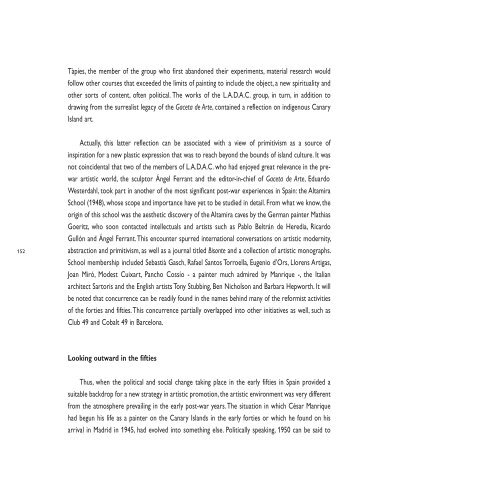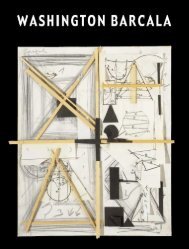VERSIÓN INGLESA ENGLISH VERSION - Fundación César Manrique
VERSIÓN INGLESA ENGLISH VERSION - Fundación César Manrique
VERSIÓN INGLESA ENGLISH VERSION - Fundación César Manrique
You also want an ePaper? Increase the reach of your titles
YUMPU automatically turns print PDFs into web optimized ePapers that Google loves.
152<br />
Tàpies, the member of the group who first abandoned their experiments, material research would<br />
follow other courses that exceeded the limits of painting to include the object, a new spirituality and<br />
other sorts of content, often political. The works of the L.A.D.A.C. group, in turn, in addition to<br />
drawing from the surrealist legacy of the Gaceta de Arte, contained a reflection on indigenous Canary<br />
Island art.<br />
Actually, this latter reflection can be associated with a view of primitivism as a source of<br />
inspiration for a new plastic expression that was to reach beyond the bounds of island culture. It was<br />
not coincidental that two of the members of L.A.D.A.C. who had enjoyed great relevance in the prewar<br />
artistic world, the sculptor Ángel Ferrant and the editor-in-chief of Gaceta de Arte, Eduardo<br />
Westerdahl, took part in another of the most significant post-war experiences in Spain: the Altamira<br />
School (1948), whose scope and importance have yet to be studied in detail. From what we know, the<br />
origin of this school was the aesthetic discovery of the Altamira caves by the German painter Mathias<br />
Goeritz, who soon contacted intellectuals and artists such as Pablo Beltrán de Heredia, Ricardo<br />
Gullón and Ángel Ferrant. This encounter spurred international conversations on artistic modernity,<br />
abstraction and primitivism, as well as a journal titled Bisonte and a collection of artistic monographs.<br />
School membership included Sebastià Gasch, Rafael Santos Torroella, Eugenio d’Ors, Llorens Artigas,<br />
Joan Miró, Modest Cuixart, Pancho Cossío - a painter much admired by <strong>Manrique</strong> -, the Italian<br />
architect Sartoris and the English artists Tony Stubbing, Ben Nicholson and Barbara Hepworth. It will<br />
be noted that concurrence can be readily found in the names behind many of the reformist activities<br />
of the forties and fifties. This concurrence partially overlapped into other initiatives as well, such as<br />
Club 49 and Cobalt 49 in Barcelona.<br />
Looking outward in the fifties<br />
Thus, when the political and social change taking place in the early fifties in Spain provided a<br />
suitable backdrop for a new strategy in artistic promotion, the artistic environment was very different<br />
from the atmosphere prevailing in the early post-war years. The situation in which <strong>César</strong> <strong>Manrique</strong><br />
had begun his life as a painter on the Canary Islands in the early forties or which he found on his<br />
arrival in Madrid in 1945, had evolved into something else. Politically speaking, 1950 can be said to
















![Becas y premios de la Fundación César Manrique [1997-2006]](https://img.yumpu.com/20766851/1/184x260/becas-y-premios-de-la-fundacion-cesar-manrique-1997-2006.jpg?quality=85)
